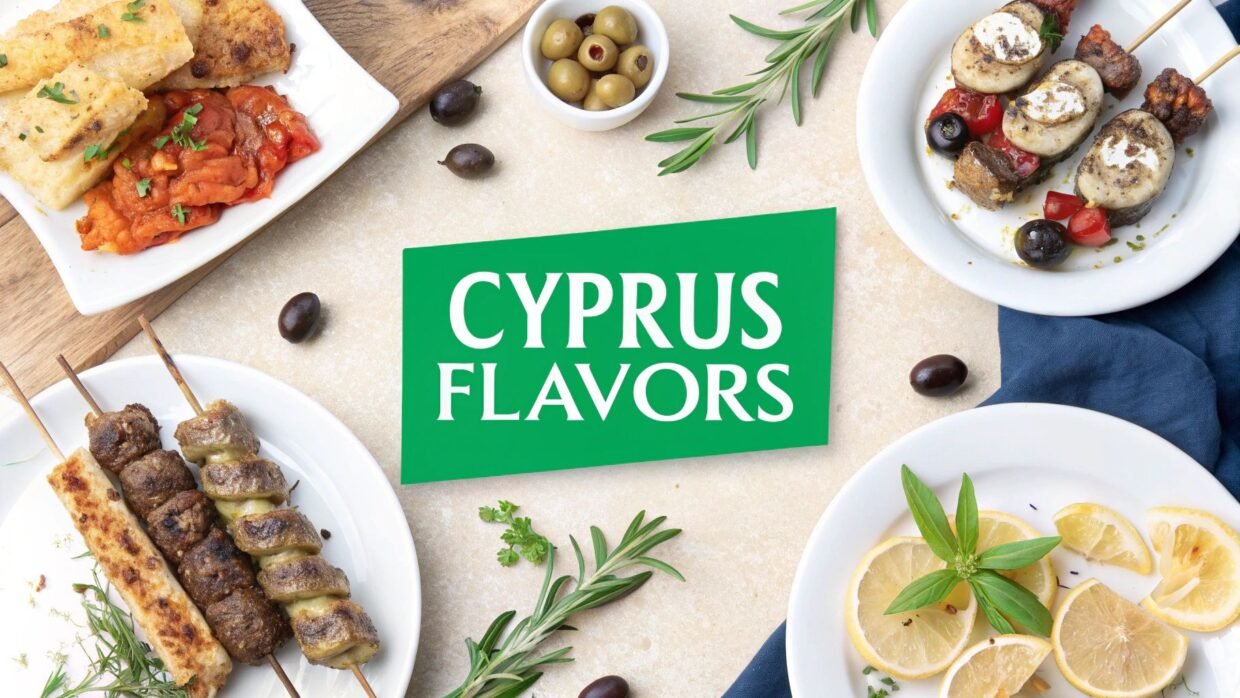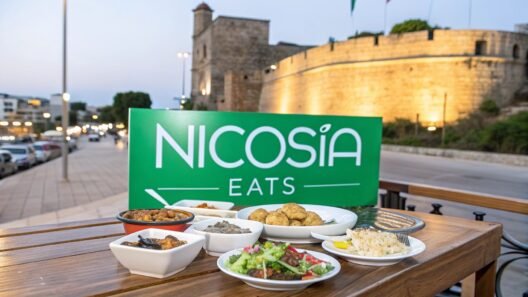Welcome to a culinary exploration of Cyprus, an island where every meal tells a story steeped in history and hospitality. More than just a destination for sun-seekers, Cyprus boasts a rich gastronomic heritage, a flavourful fusion of Greek, Turkish, and Middle Eastern influences that creates a truly unique culinary identity. This guide moves beyond the typical tourist trail to introduce you to the authentic taste of the island, offering a curated selection of essential Cyprus traditional foods that define the nation's palate.
This is not just a list; it is a practical guide designed for travellers seeking genuine gastronomic experiences. We will delve into eight quintessential dishes, from the communal joy of a slow-cooked Souvla to the comforting layers of a home-made Moussaka. For each entry, you will find more than just a description. We will uncover the cultural significance, provide actionable tips on what makes each dish special, and offer specific recommendations on the best places to find the most memorable meals during your journey.
Prepare to discover the heart of the Cypriot kitchen. This article will equip you with the knowledge to order with confidence, understand the traditions behind the food on your plate, and ultimately, to eat like a local.
1. Halloumi (Χαλλούμι)
No list of Cyprus traditional foods would be complete without its most iconic export: Halloumi. This unique, semi-hard cheese is traditionally made from a blend of sheep's and goat's milk, though modern varieties often include cow's milk. Its fame comes from a remarkable high melting point, which allows it to be grilled or fried to a perfect golden-brown crust while the inside softens but never melts into a puddle.
This cheese, which has Protected Designation of Origin (PDO) status in the European Union, has a distinctively layered, almost chewy texture and a mild, briny flavour. When eaten fresh, it has a signature "squeak" against the teeth, a characteristic cherished by locals and food enthusiasts alike. Its versatility makes it a cornerstone of Cypriot cuisine, enjoyed in countless ways.
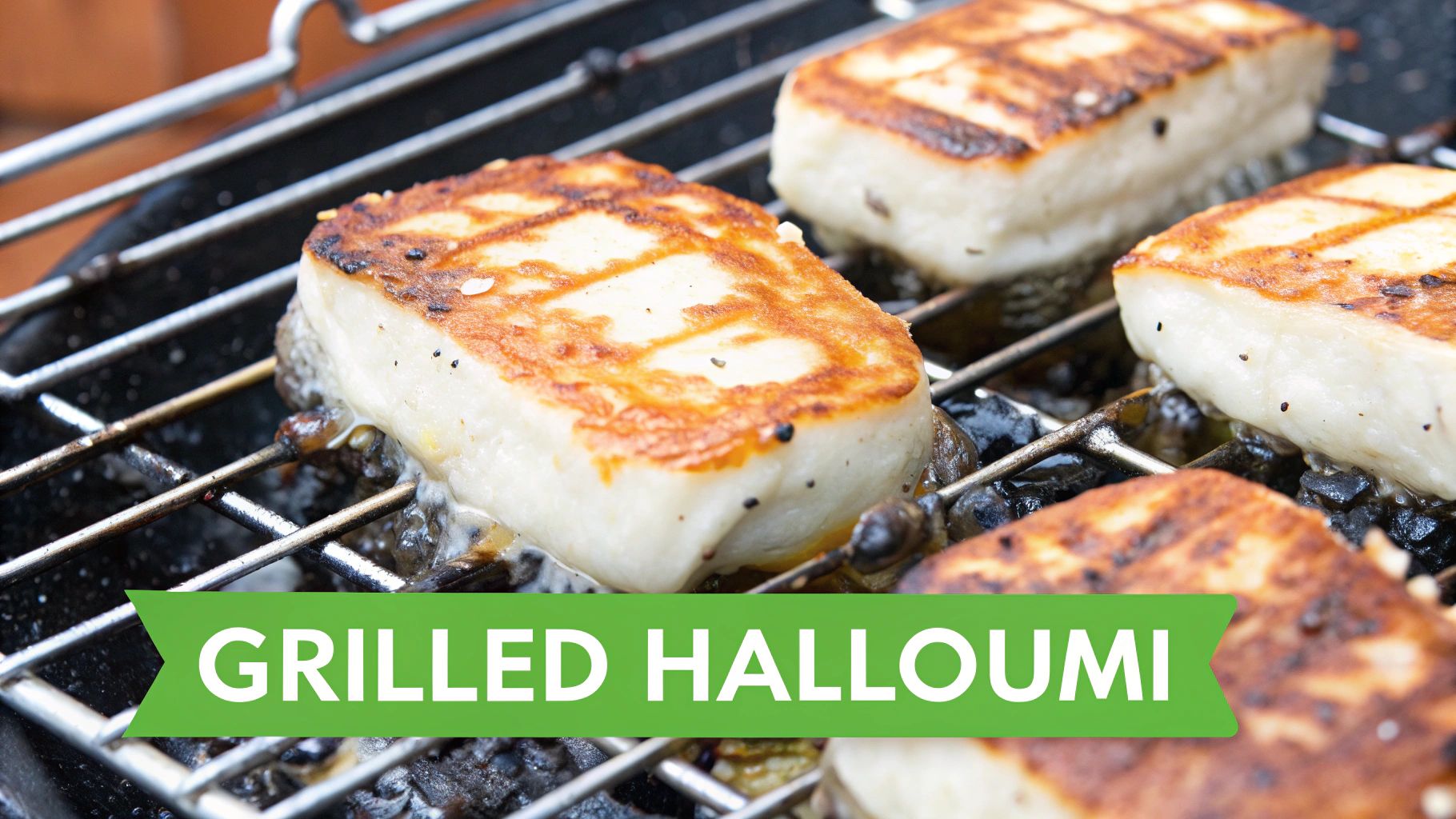
How to Enjoy Halloumi
While delicious on its own, Halloumi truly shines when paired with other ingredients. In a traditional Cypriot village breakfast, fresh slices are served alongside sweet watermelon and aromatic mint for a refreshing summer meal. Modern tavernas have popularised Halloumi fries as a starter, often served with a pomegranate and yoghurt dip. It also frequently appears in salads, sandwiches, and even as a vegetarian alternative to a meat burger patty.
Pro Tips for Cooking
To get the most out of your Halloumi, follow these simple guidelines:
- Reduce Saltiness: If you find your Halloumi too salty, soak it in cold water or milk for about 30 minutes before cooking.
- Grill it Right: Cook slices over a medium-high heat for just 2-3 minutes per side. You're looking for deep golden-brown grill marks and a soft centre.
- Serve Immediately: Halloumi is at its best when served hot, straight from the grill or pan, as it can become tough once it cools.
- Perfect Pairings: The salty cheese contrasts beautifully with sweet flavours. Try drizzling it with honey or serving it with a fig jam for a delightful appetiser.
2. Souvla (Σούβλα)
More than just a dish, Souvla is a cornerstone of Cypriot social life and a true spectacle of traditional cooking. It consists of large, substantial chunks of meat, typically pork, lamb, or chicken, skewered on long metal rods. Unlike its Greek counterpart, souvlaki, which uses smaller pieces cooked quickly, Souvla is defined by its slow-cooking process over a charcoal fire known as a foukou (φουκού). This leisurely cooking, often lasting two to three hours, is a communal event in itself.
The slow rotation and gentle heat render the meat incredibly tender and succulent on the inside, while developing a deliciously smoky and crisp exterior. This method is central to countless Cypriot celebrations, from Easter Sunday feasts to family gatherings and village festivals (panigiri). It embodies the island's spirit of hospitality and shared culinary experience, making it one of the most beloved Cyprus traditional foods.
The infographic below outlines the essential steps for preparing authentic Souvla, a process that prioritises patience and simplicity.
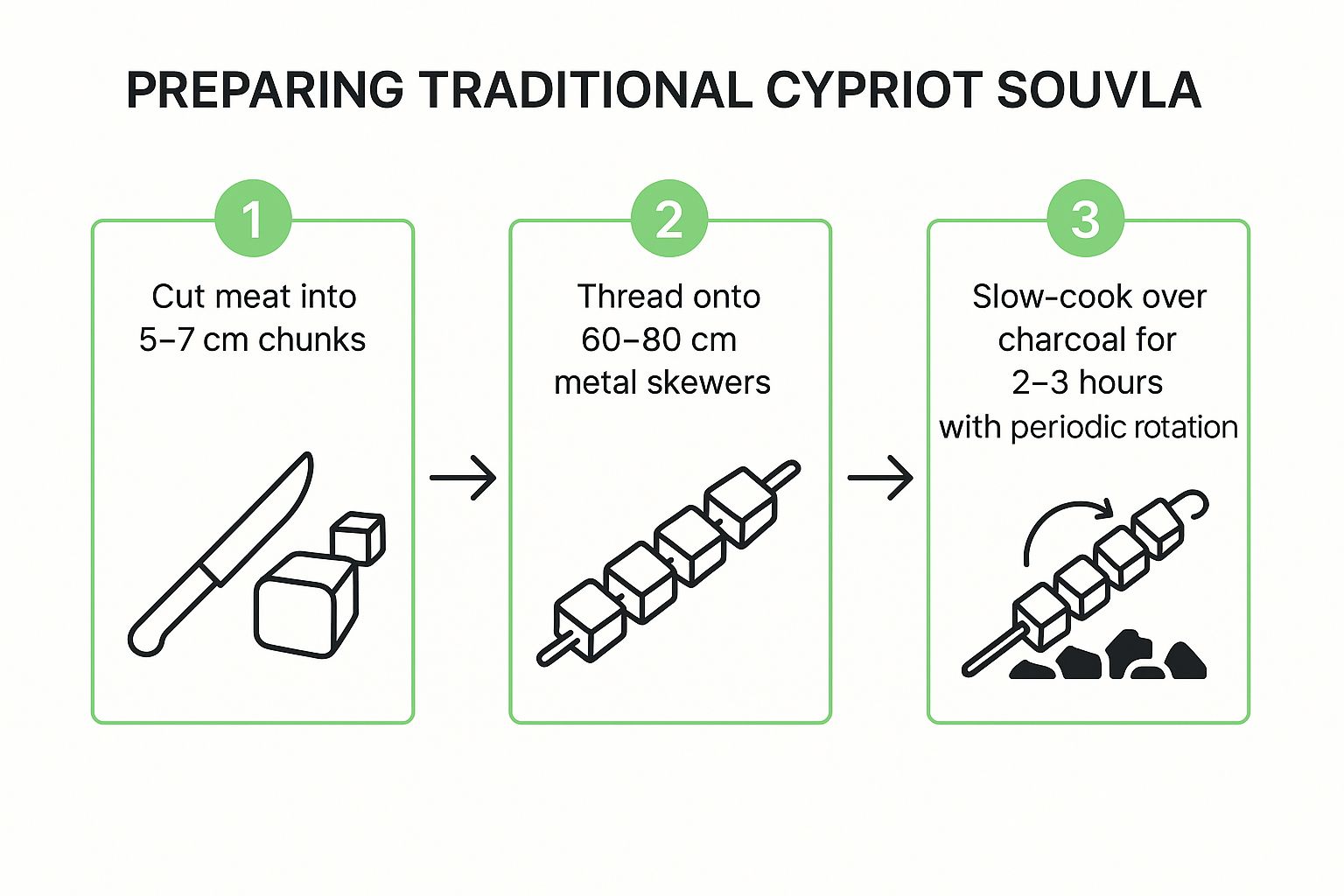
This simple, three-step process highlights how the magic of Souvla lies not in complex techniques but in the quality of the meat and the slow, patient cooking over charcoal.
How to Enjoy Souvla
Souvla is almost always served as a main course, often as part of a larger meze or a celebratory meal. It is typically accompanied by fresh salads, potatoes (either baked in the charcoal embers or fried), pita bread, and a variety of dips like tzatziki or tahini. You'll find it at every major family gathering, from Sunday lunches to weddings. Many traditional tavernas, especially in the Troodos mountains, specialise in Souvla, offering a rustic and authentic dining experience.
Pro Tips for Cooking
To master the art of Souvla, focus on the fundamentals:
- Maintain Consistent Heat: The goal is a steady, medium heat from the charcoal. Avoid high flames which will char the outside before the inside is cooked.
- Season Simply: A generous amount of salt, pepper, and oregano is all you need. The flavour should come from the high-quality meat and the smoke.
- Let it Rest: Once cooked, allow the meat to rest on the skewer for at least 10 minutes. This allows the juices to redistribute, ensuring every piece is moist and flavourful.
- Start with Quality: Use fresh, good-quality meat from a trusted butcher. The size of the chunks (around 5-7 cm) is crucial for slow cooking without drying out. For more in-depth information, you can explore other resources covering traditional food from Cyprus.
3. Kleftiko (Κλέφτικο)
A true showstopper in the world of Cyprus traditional foods, Kleftiko is a rustic and incredibly succulent slow-cooked lamb dish steeped in history. The name derives from the Greek word ‘kleftis’ (thief), a nod to the bandits who would steal sheep and cook them in sealed, underground earth ovens. This clandestine cooking method prevented smoke from revealing their location, and the technique has been perfected over centuries.
Today, large chunks of lamb, often on the bone, are marinated in lemon juice, garlic, and herbs like oregano and bay leaves. The meat is then slow-cooked with potatoes for several hours in a sealed clay oven or tightly wrapped parchment paper. This method traps all the steam and juices, tenderising the meat until it literally falls off the bone and infusing every bite with an intensely aromatic flavour that is truly unforgettable.
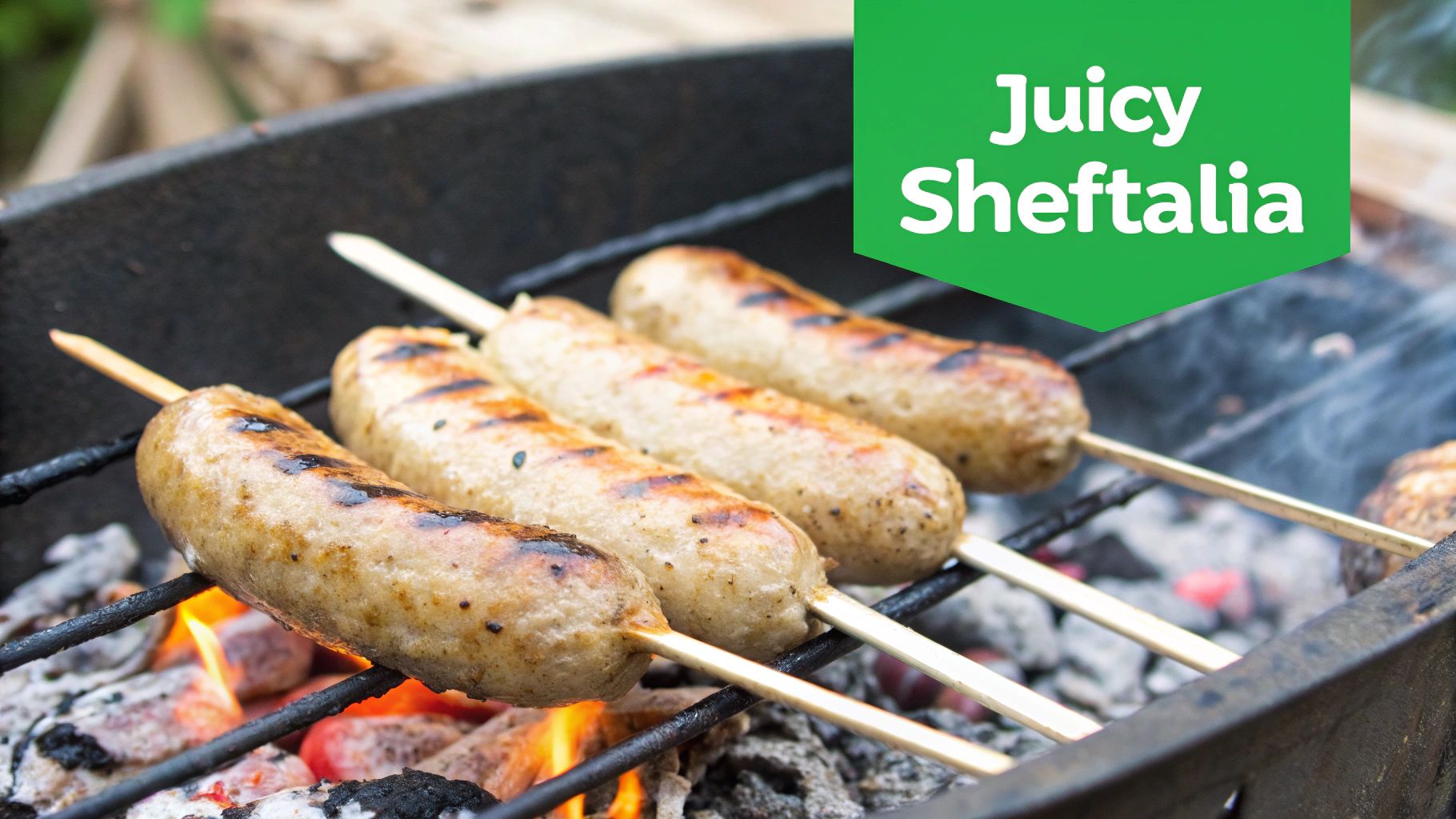
Where to Enjoy Kleftiko
Kleftiko is a staple at traditional tavernas, especially in mountain villages where the authentic clay oven method is still widely used. Restaurants like Voreas Tavern in Platres and Militzis Restaurant in Larnaca are renowned for their exceptional Kleftiko. It is also a celebratory dish, often served as the main course at Cypriot weddings and family gatherings. For a deeper dive into this classic dish, you can explore more about Kleftiko (Κλέφτικο) and other culinary treasures.
Pro Tips for the Perfect Kleftiko
While best enjoyed from a traditional clay oven, you can recreate this masterpiece at home with these tips:
- Best Cut of Meat: Use lamb shoulder or leg for the ideal balance of meat and fat, which guarantees a tender result.
- Marinate Generously: For the deepest flavour penetration, marinate the lamb overnight in lemon juice, garlic, olive oil, and herbs.
- Seal it Tight: Ensure your cooking vessel or parchment paper parcel is completely sealed. The trapped steam is the secret to the dish's signature tenderness.
- Low and Slow: Cook at a low temperature, around 160°C (320°F), for at least 3-4 hours. Patience is key.
- Don't Waste the Juices: After cooking, let the meat rest for 10 minutes before serving. Drizzle the flavourful cooking juices over the lamb and potatoes.
4. Meze (Μεζέ)
More of a grand culinary event than a single dish, the Cypriot meze is the ultimate expression of the island's hospitality and love for communal dining. This is not just a meal; it's a social ritual. A meze consists of a seemingly endless succession of small dishes, often numbering between 20 and 30, that arrive at the table in carefully orchestrated waves. It’s a marathon of flavours, designed to be shared among friends and family over several hours of conversation and laughter.
The experience starts with light, cold appetisers like fresh salads, olives, and a variety of dips such as tahini, taramosalata, and houmous, all served with warm pitta bread. It then progresses through grilled vegetables, local delicacies like halloumi and lountza (smoked pork loin), and culminates in a rich assortment of grilled meats, including souvlaki, sheftalia, and lamb chops. This elaborate feast showcases the diversity of Cyprus traditional foods in one sitting.
How to Enjoy Meze
The true essence of meze is sharing. It is best enjoyed in a lively taverna with a group of friends or family, such as the iconic Zanettos Tavern in Nicosia or Stou Kir Yianni in Paphos, which are renowned for their authentic offerings. The goal is not to finish every plate but to sample a wide array of textures and flavours. From seafood-focused meze in coastal tavernas to meat-centric feasts in mountain villages, the experience can vary, offering a new adventure each time. To dive deeper into what a full spread entails, you can learn more about the complete Cypriot traditional cuisine on saycyprus.com.
Pro Tips for the Meze Experience
To fully embrace this Cypriot tradition, keep these tips in mind:
- Arrive Hungry: This cannot be overstated. With over 20 dishes heading your way, a hearty appetite is essential.
- Pace Yourself: The dishes come out gradually over two to three hours. Don't fill up on the initial salads and dips; there is much more to come.
- Go with a Group: Meze is designed for sharing. A group of four or more is ideal to sample everything without being overwhelmed.
- Be Adventurous: You will encounter dishes you may not recognise. This is the perfect opportunity to try something new and discover a new favourite.
- Signal When You're Done: The food will often keep coming until you signal to your waiter that you've had enough. A simple "that's plenty, thank you" will do the trick.
5. Moussaka (Μουσακάς)
A true heavyweight of Cypriot comfort food, Moussaka is a rich, baked casserole that warms the soul. While many associate the dish with Greece, the Cypriot version has its own distinct identity. This hearty meal is built on layers of fried potato slices, spiced minced meat, and is crowned with a thick, creamy béchamel sauce that’s baked until golden and bubbling. It’s a quintessential dish found in every traditional taverna and home across the island.
The key difference lies in the base layer; Cypriot Moussaka predominantly uses potatoes, creating a more substantial and comforting dish, whereas the Greek version famously features eggplant. The meat sauce is another point of pride, slow-simmered with tomatoes and a fragrant blend of cinnamon and allspice, infusing the entire casserole with a uniquely Cypriot flavour. This dish is a centrepiece of family gatherings, especially for a Sunday lunch.
How to Enjoy Moussaka
Moussaka is a complete meal in itself, typically served as a main course. A generous square portion is cut from the large baking tray and is best enjoyed warm, not piping hot, allowing the complex flavours to meld together perfectly. It’s often accompanied by a simple village salad (horiatiki) of cucumber, tomatoes, onions, and feta, whose fresh, crisp texture cuts through the richness of the bake. You’ll find it served daily in traditional tavernas, and many local bakeries (fourni) offer it by the slice for a satisfying takeaway lunch.
Pro Tips for Cooking
Achieving the perfect Moussaka requires patience and attention to detail:
- Rest Before Serving: This is crucial. Let the Moussaka rest for at least 20-30 minutes after baking. This allows the layers to set, ensuring you get a clean, beautiful slice that doesn't fall apart.
- Thick Béchamel: Your béchamel sauce should be thick enough to coat the back of a spoon. A pinch of nutmeg is a classic addition that elevates its flavour.
- Savoury Meat Sauce: Let your meat sauce simmer for a minimum of 30 minutes. This slow cooking process is essential for developing the deep, aromatic flavours from the cinnamon and allspice.
- Golden Potatoes: Fry the potato slices until they are just golden but not fully cooked or crispy. They will finish cooking in the oven and absorb the delicious flavours from the meat sauce.
6. Sheftalia (Σεφταλιά)
A true star of the Cypriot barbecue, Sheftalia are uniquely flavourful and juicy sausages unlike any other. These rustic, casing-free creations are made from minced pork or a mix of pork and lamb, blended with finely chopped parsley, onions, and delicate spices. The mixture is then wrapped in caul fat, the lacy, fatty membrane from a lamb or pig, which melts away during grilling to baste the meat and create a distinctive, crispy exterior.
This traditional method keeps the inside incredibly moist and tender while infusing it with a rich, savoury flavour. The name is thought to derive from the Turkish word for peach, 'şeftali', perhaps alluding to their plump, rounded shape. As a cornerstone of Cypriot meze platters and a popular street food, Sheftalia represent the heart of the island’s grilling culture and are a must-try among Cyprus traditional foods.
How to Enjoy Sheftalia
Sheftalia are almost always cooked over a charcoal grill, which imparts a wonderful smoky aroma. They are a non-negotiable part of any Cypriot barbecue, often served alongside souvla or souvlaki. The most classic way to enjoy them is tucked into a warm Cypriot pita bread with fresh tomato, cucumber, parsley, and a generous squeeze of lemon juice. You will find them featured prominently in village tavernas like Pyrgos Tavern in Limassol and sold hot off the grill at street food stalls in Nicosia's old town.
Pro Tips for Cooking
To cook Sheftalia like a true Cypriot, keep these tips in mind:
- Source Quality: For the most authentic flavour, purchase fresh Sheftalia from a traditional Cypriot butcher (hasapides), who will have their own time-honoured recipe.
- Gentle Grilling: Cook over medium, consistent heat. The delicate caul fat can burn easily, so avoid high flames. Turn them gently to prevent the wrapping from tearing.
- Keep Them Juicy: Resist the urge to press down on the sausages as they cook. This will squeeze out the delicious juices that make them so succulent.
- Serve Immediately: Sheftalia are best eaten straight from the grill while the caul fat is perfectly crisp and the filling is hot and juicy. They become less appealing as they cool.
7. Stifado (Στιφάδο)
As one of the heartiest and most aromatic of all Cyprus traditional foods, Stifado is a rich, slow-cooked stew that warms the soul. Traditionally made with either beef or rabbit, its defining characteristic is the generous amount of small pearl onions, often equalling the meat in weight. The meat is braised for hours in a fragrant sauce of red wine, a touch of vinegar, tomato, and a distinctive blend of warm spices like cinnamon, allspice, and bay leaves.
This beloved dish, with culinary roots tracing back to Venetian influences, has been wholeheartedly embraced and adapted into Cypriot cuisine. The long, gentle cooking process transforms the meat until it is fork-tender and allows the pearl onions to soften completely, absorbing the deep flavours and creating a naturally sweet, thick sauce. It’s a quintessential comfort food, especially popular in the cooler mountain villages during winter.
How to Enjoy Stifado
Stifado is a substantial main course, typically served hot with accompaniments that can soak up its incredible sauce. In traditional mountain tavernas, like those in the Troodos or Marathasa regions, you will find it served with fluffy cracked wheat pilaf (pourgouri), potatoes, or simply a basket of crusty village bread. It is a centrepiece dish for Sunday family lunches and is frequently featured at village festivals and name day feasts, bringing families and communities together.
Pro Tips for Cooking
To create an authentic and flavourful Stifado, focus on the details:
- Easy-Peel Onions: To save time, blanch the pearl onions in boiling water for one minute before peeling. The skins will slide right off.
- Build Flavour: Ensure you brown the meat well in batches before adding any liquid. This searing process creates a deep, savoury foundation for the stew.
- Low and Slow: The key to tender meat and perfectly soft onions is patience. Cook the stew over a very low heat for at least 2-3 hours, allowing the flavours to meld beautifully.
- Better the Next Day: Like many stews, Stifado's flavour deepens and improves overnight. Consider making it a day in advance for the best taste experience.
8. Koupepia / Dolmades (Κουπέπια)
A true labour of love in Cypriot cuisine, Koupepia are delicate vine leaves stuffed with a savoury filling. This beloved dish is a staple at family gatherings and celebrations, representing the heart of home-style cooking. The filling typically consists of minced pork or beef, rice, finely chopped onions, fresh tomatoes, and a fragrant blend of herbs like parsley and mint.
While similar to the Greek dolmades, the Cypriot version is distinct. Koupepia almost always include meat and are simmered slowly in a rich tomato and lemon sauce, which infuses the parcels with a tangy, comforting flavour. The process of carefully rolling each leaf is a cherished tradition, often done in large batches by families, with the results being a testament to the patience and care central to many Cyprus traditional foods.
How to Enjoy Koupepia
Koupepia are wonderfully versatile and can be served as part of a larger meze spread or as a main course. They are delicious both warm from the pot or served at room temperature, making them perfect for any occasion, from a formal wedding buffet to a casual Sunday lunch. A generous dollop of thick Greek yoghurt is the traditional and most popular accompaniment, its cool creaminess perfectly balancing the zesty, savoury filling of the rolls.
Pro Tips for Cooking
Achieving the perfect, tender Koupepia requires attention to detail. Follow these tips passed down by Cypriot yiayiades (grandmothers):
- Prepare the Leaves: If using fresh vine leaves, blanch them in boiling water for a minute to make them soft and pliable. If using brined leaves, rinse them thoroughly to remove excess salt.
- Don't Overfill: Use about a teaspoon of filling per leaf. The rice will expand during cooking, and overfilling can cause the parcels to burst open.
- Layer the Pot: Use any torn or imperfect leaves to line the bottom of your cooking pot. This prevents the Koupepia from sticking and burning.
- Keep them Submerged: Place a small, heatproof plate on top of the rolled leaves in the pot before adding the cooking liquid. This weight keeps them submerged and helps them cook evenly.
- Serve with Yoghurt: For the most authentic experience, serve your homemade Koupepia with a side of thick, plain Greek yoghurt for dipping.
Traditional Cypriot Foods Comparison Table
| Item | 🔄 Implementation Complexity | ⚡ Resource Requirements | 📊 Expected Outcomes | 💡 Ideal Use Cases | ⭐ Key Advantages |
|---|---|---|---|---|---|
| Halloumi | Moderate – requires brining and careful cooking to avoid rubberiness | Medium – quality milk, brine, and grilling equipment | Versatile cheese with firm texture, suitable for grilling/frying | Casual meals, vegetarian dishes, appetizers | High melting point, versatile use, long shelf life, protein-rich |
| Souvla | High – slow cooking with manual skewer rotation over charcoal for 2-3 hours | High – outdoor charcoal grill, large meat cuts, space | Tender, smoky meat with deep flavor and communal cooking experience | Social gatherings, celebrations, large groups | Economical for feeding crowds, strong cultural connection |
| Kleftiko | High – marination and sealed slow cooking (3-4 hours) in oven or clay pot | Medium – quality lamb, parchment/clay oven | Extremely tender, aromatic meat infused with herbs | Family dinners, special occasions, rustic cooking | Sealed cooking traps flavors, minimal hands-on time |
| Meze | Very High – preparation of 20-30 varied small dishes served sequentially | High – variety of ingredients, longer service time | Comprehensive tasting experience and social dining | Group dining, cultural immersion | Wide variety, social and interactive, authentic hospitality |
| Moussaka | Moderate to High – multiple components (fried potatoes, meat sauce, béchamel) | Medium – diverse ingredients and baking equipment | Hearty, filling casserole with layered flavors | Family meals, comfort food, make-ahead dishes | Can be prepared in advance, freezes well, feeds many |
| Sheftalia | Moderate – forming sausages with caul fat wrap, quick charcoal grilling | Medium – access to caul fat, fresh minced meat, charcoal grill | Juicy, flavorful sausages with unique texture | Meze menus, street food, quick grilling | Natural casing, quick cook time, distinct flavor |
| Stifado | High – peeling many pearl onions, long slow stew cooking (2-3 hrs) | Medium – meat, pearl onions, wine, spices | Rich, sweet-sour stew with tender meat | Winter comfort food, meal prep, slow cooking | Deep complex flavors, economical, meal prep friendly |
| Koupepia | Very High – labor-intensive rolling, long cooking, batch preparation | Medium – fresh/preserved vine leaves, meat, rice | Tender stuffed vine leaves with aromatic lemon-tomato sauce | Family gatherings, holidays, batch cooking | Freezable, healthy portions, impressive presentation |
Your Culinary Adventure in Cyprus Awaits
As we've journeyed through the heart of Cypriot gastronomy, from the unmistakable squeak of grilled halloumi to the slow-cooked perfection of kleftiko, it becomes clear that food on this island is a language of its own. It speaks of history, community, and an unwavering respect for fresh, local ingredients. The dishes we’ve explored are not just menu items; they are cornerstones of a culture that celebrates life around the dinner table, making the exploration of Cyprus traditional foods an essential part of any visit.
Each plate tells a story. The communal joy of a meze captures the island’s spirit of generosity, while the Sunday ritual of preparing souvla over charcoal embodies the importance of family and tradition. These culinary experiences offer more than just nourishment; they provide a direct connection to the island’s soul and the warmth of its people.
Key Takeaways for Your Cypriot Food Journey
To truly immerse yourself in the island's culinary landscape, keep these insights in mind:
- Embrace the Meze: Don't just see it as an appetiser. A full meze is an event, a progressive feast that showcases the breadth of Cyprus traditional foods. Go hungry, pace yourself, and prepare for an unforgettable marathon of flavours.
- Seek Out Village Tavernas: While city restaurants offer fantastic meals, the most authentic and memorable dishes are often found in smaller, family-run establishments in the mountains or coastal villages. This is where recipes passed down through generations truly shine.
- Understand the Context: Savouring kleftiko is more meaningful when you know its rebellious history, and enjoying koupepia connects you to a culinary tradition shared across the Eastern Mediterranean. Understanding the story behind the food enriches the entire experience.
Your Next Steps to Authentic Flavour
Now that you're equipped with this knowledge, your culinary adventure is ready to begin. The most valuable step you can take is to move beyond the tourist trails. Engage with local vendors at a farmer's market, ask your taverna owner for their personal recommendation, or accept an invitation to a family barbecue if you're lucky enough to receive one.
Mastering the art of eating in Cyprus is about embracing this spirit of discovery and connection. It’s about realising that every shared meal is an opportunity to create a lasting memory. The flavours of stifado, sheftalia, and perfectly seasoned moussaka are waiting to become part of your own travel story, offering a delicious and profound way to experience the real essence of the Aphrodite's Isle. So, pull up a chair, raise a glass of local wine, and get ready to say “Kali Orexi!”
Ready to plan the rest of your trip? For curated guides on the best local tavernas, regional food festivals, and insider travel tips that go beyond the plate, visit SayCyprus. We provide the detailed local knowledge you need to transform your holiday into an authentic Cypriot experience. Discover your next adventure at SayCyprus.









